Press pliers for metal-plastic pipes: how to choose + instructions for use
For laying, installation and repair of communication systems made of metal-plastic material, a special tool is used - press pliers for metal-plastic pipes.This device allows you to carefully process the parts and ensure a reliable, tight and strong connection of all the fragments with each other.
The system assembled using press jaws is characterized by durable operation, guarantees mechanical strength in the joint areas and does not require subsequent labor-intensive maintenance. We will tell you how to choose a tool and how to use it correctly in practice. The care tips we provide will help extend its working life.
The content of the article:
- Types of press jaws
- Features of Hand Crimping Tool
- How are metal-plastic pipes connected?
- Preparing pipes for processing with press jaws
- How is crimping done with a handheld device?
- Features of using press jaws
- Safety precautions when working with the tool
- How to care for press tongs?
- Conclusions and useful video on the topic
Types of press jaws
According to one classification, crimping pliers for metal-plastic and plastic pipes There are three types: manual (mini and standard), hydraulic and electric.
Mini hand pliers are the simplest crimping tool designed for home use. The device has small, compact dimensions and weighs about 2.5 kilograms without attachments. Fits comfortably in the hand and ensures correct crimping of the coupling on pipes with a diametrical cross-section of up to 20 millimeters.
It is equipped with a set of several nozzles designed for pipe material of different calibers. Thanks to the presence of axial eccentrics, it allows you to make additional adjustments if excess play occurs during machining.
The standard manual model has a crimping head made of a high-strength metal alloy.Comfortable, elongated, telescopic handles, attached to the head using a gear mechanism, help you easily adjust the level of compression force.
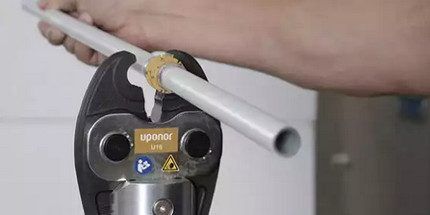
Using a tool designed to make connections manually does not require a person to have specific knowledge or extensive experience in installation work.
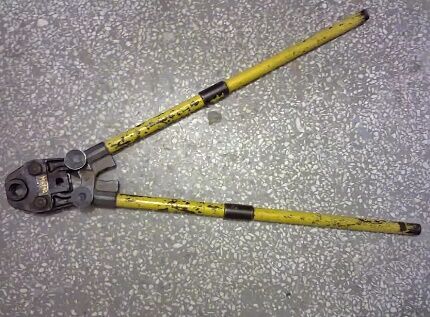
For carrying out one-time household repairs or installing the necessary communications made of metal-plastic inside the house, a manual press is simply ideal and can easily cope with all the loads that arise in the process. The kit usually includes additional spacers that make it possible to crimp pipes of different diameters.
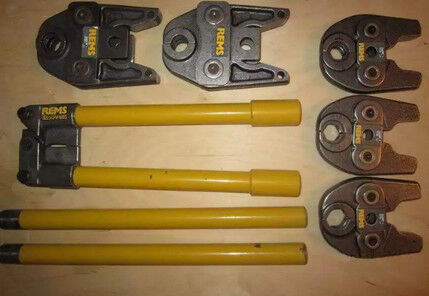
However, there are a number of limitations for a hand tool, and its crimping capabilities only apply to small-caliber material (no more than 26 mm). WITH metal-plastic pipes large size hand pliers are not effective, but in everyday life this is not too important.Indeed, in private houses, cottages and city apartments, standard types of pipes with a small cross-section are predominantly installed.
There is a hydraulic cylinder on one of the handles of the hydraulic press jaws. It is mechanically connected to the crimping head by the output rod. In the process of bringing the handles together, the piston enters the hydraulic cylinder and creates operating pressure that is transmitted to the head.

Human muscular strength is practically not used, but the device itself is much more expensive than the manual version and requires regular maintenance.
Models with electric drive are small in size and light in weight, but are highly efficient and can easily withstand increased operating loads.
When carrying out repair and installation activities, the employee does not have to make significant efforts to complete the task. This significantly speeds up the process, reduces its cost and significantly reduces labor costs.

Press pliers with an electric drive make a clear, even crimp, easily process pipes with a diameter of up to 110 millimeters and function efficiently when laying large-scale communications. They speed up the process of forming individual fragments into a common system and are equipped with attachments that expand the range of pipes available for crimping.
Based on the type of power supply, electric press tools for metal-plastic and other pipes are divided into three subclasses:
- rechargeable – receive power from a built-in battery, suitable for use where it is not possible to connect to the mains; on one charge carry out from 50 to 100 crimps;
- network - operate from a regular 220W electrical outlet;
- universal - demonstrate the same efficiency in both modes (battery/socket).
The only disadvantage of the model is its rather large dimensions, which do not allow comfortable use of the tool in difficult, cramped conditions.
In devices with an electric-hydraulic drive, only universal removable heads are used for crimping onto a separate base section of metal-plastic pipe material. The load during processing is distributed over the entire joint area, and the tool itself operates more softly and smoothly. The quality of the connections after such crimping is impeccable.
The choice of a suitable model of press jaws for metal plastic directly depends on the scale of the proposed work and the diameter of the pipes to be crimped.
Professional plumbers prefer to use electric or hydraulic pliers. Owners of houses and apartments buy manual equipment because they do not plan any major work related to the installation and laying of metal-plastic communication systems.
This is interesting! TOP 9 best hydraulic presses.
Features of Hand Crimping Tool
In addition to their direct functions, certain models of manual press pliers have some additional functions that facilitate the installation process and promote compliance with basic safety rules during operation:
- O.P.S. - an expansion option aimed at increasing muscle strength using a progressive four-stage clamp.
- APC – a unique system that monitors the correct execution of the connection (does not allow the pliers to be removed from the pipe until the clamping is completely completed).
- APS – a progressive device for the correct distribution of applied force depending on the dimensions of the press fitting.
When planning to purchase a manual press jaw for metal-plastic, first determine the diameter of the pipes used, and then, based on this data, find out whether the store has a tool of the same diameter and intended fittings for crimping, used to make connections.
If you need to crimp pipes of different sizes, take the maximum cross-section of the part as a basis. A large-diameter tool can also cope with smaller pipes, since the kit always includes additional inserts that allow this operation to be carried out.
The entire process of creating a connection using press jaws includes several standard steps:
How are metal-plastic pipes connected?
In the process of laying metal-plastic pipes, special connecting parts - fittings - are used. They are fastening elements or nodal branches - crosses, tees, adapters, plugs, etc.
There are two types of these parts - compression and press. To install the former, you need a regular wrench, and for the latter, crimping pliers. WITH range of fittingsThe article we recommend will familiarize you with the materials used for assembling metal-plastic pipelines.

The press fitting is considered the most reliable and does not weaken during operation, minimizing the possibility of leaks in systems. This method of connection makes it possible to fill communications with concrete and, if necessary, carry out hidden laying of metal-plastic pipes in walls, floors and ceilings.
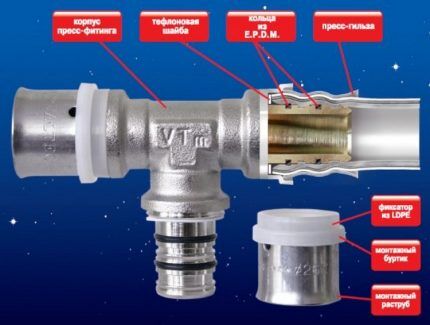
The connection area demonstrates excellent performance, easily withstands pressure several times higher than the maximum permissible pressure in the pipes themselves, exhibits high mechanical strength and reliably serves for many years, without requiring unnecessary attention and labor-intensive maintenance activities.
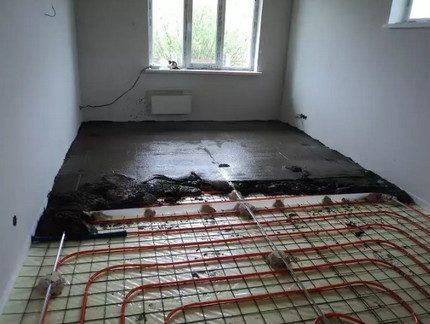
To install fittings in metal-plastic pipes, crimping pliers of any type are used. With their help, crimping occurs quickly and efficiently, and the result is a clear, permanent connection, almost completely eliminating a breakthrough on the communication line.
When using press fittings, the system turns into a solid, non-separable complex. Errors made during the installation process cannot be corrected or repaired. To eliminate them, you will have to cut out the fragment and install a new communication node.
Another disadvantage is the rather high price of press parts. That is why they are not used very widely in everyday life.
Preparing pipes for processing with press jaws
Immediately before assembly of metal-plastic systems, i.e. Before using press jaws and carrying out crimping activities, the pipe material is prepared accordingly.
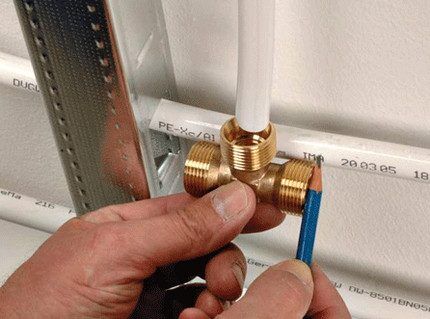
The sequence of actions is relevant for any type of tool and requires mandatory compliance:
- Using a tape measure, measure out the required amount of pipe material from the coil and make a mark with a marker where the intended cut will be.
- Using scissors for cutting metal-plastic, cut off a part of the required length, making sure that the resulting edge is as smooth as possible and makes a clear right angle with the conditional central axis of the product.
- When using a guillotine tool for work, its lower edge is held strictly parallel to the surface of the pipe, only slightly pressing the cutting part into the pliable material.
- When the trimming is done, the resulting end edges are processed with a calibrator. He corrects and aligns the shape of the cut and carefully removes the internal chamfer.
- Remove the ferrule from the fitting and place it on the edge of the pipe. The fitting is inserted directly into the cut.
- The end parts of the connection elements are pressed tightly, and the joint area is isolated with a sealing gasket. It protects the material from corrosion and ensures the tightness of the entire system as a whole.
- The placement of the pipe in the sleeve is controlled through a round cutout in the edge zone.
When the appropriate preliminary preparation is completed, proceed to the use of press pliers and carry out the crimping operation.
How is crimping done with a handheld device?
The process of crimping a metal-plastic pipe with manual press pliers is not complicated, but it requires attention and accuracy. To work, you need an empty, flat surface that allows you to place a piece of pipe, connecting fittings and the tool itself.
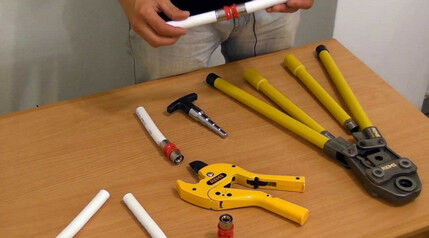
When everything necessary is prepared, the press tongs are placed on the table and the handles are moved apart 180 degrees.
The upper element of the holder is disconnected from the unit and the upper part of the press insert corresponding to the cross-sectional size of the pipe that is currently being processed is inserted into it. The lower half is placed in the lower part of the holder, which remains empty, and the tool is snapped into place.

A joint assembly is made from a pipe and a fitting and the structure is placed into press jaws, carefully ensuring that the fitting sleeve is inside the press insert.
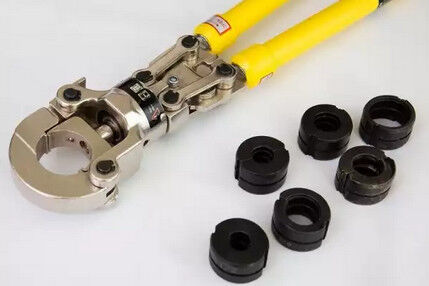
After the set of pipe and fitting is correctly placed in the device, the handles are brought together until they stop and crimped.
After the operation, two identical arcuate bends and two clearly visible annular stripes should form on the metal. And the result will be a clearly and firmly installed and secured fitting, which will be almost impossible to remove with a working tool.

You can tell if the work was done incorrectly by a loose, poorly secured nut, by the presence of an opening more than 1 millimeter wide visible between the metal-plastic pipe and the nut, and by the looseness of the nut. If such errors are found, the fitting will have to be cut out of the pipe and a new one reinstalled in its place.
Features of using press jaws
Despite the practicality and functionality of press pliers, there are places where using such a tool is very inconvenient. Repair and installation professionals say that when working with grooves laid in a false wall or under a suspended ceiling, it is wiser to take a press gun rather than pliers. It completely eliminates injury and makes it possible to control the process with one hand.
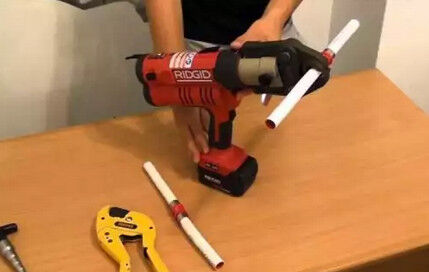
In addition, the tool can be rotated around the joint axis of the pipes, thus performing accurate, even and reliable crimping.
Practical tips for crimping metal-plastic pipes, tested in practice by plumbers, are given in the next article, the contents of which we advise you to familiarize yourself with.
Safety precautions when working with the tool
To use press tongs at home, you do not need specific knowledge or extensive work experience. You just need to carefully study the operating instructions and strictly follow everything that is written there.
Do not use the tool in rooms with high humidity. Dampness has a bad effect on metal and leads to jamming and incorrect operation of tools.
It is advisable to carry out the pressing process in comfortable, practical clothes, and protect your hands with thick construction gloves. To avoid injury and damage, do not allow parts of clothing or limbs to get into the working mechanism. Following these simple rules will help you perform crimping carefully, without damaging either yourself or the tool.
How to care for press tongs?
In order for a tool to serve reliably for a long time, it needs to be looked after. After use, it is necessary to clean the metal head with a special product, and then treat the screw and the clamping parts of the nozzle with lubricant.
It is recommended to store the device in a dry place, pre-packing it in a case or a special box, usually sold with the instrument.
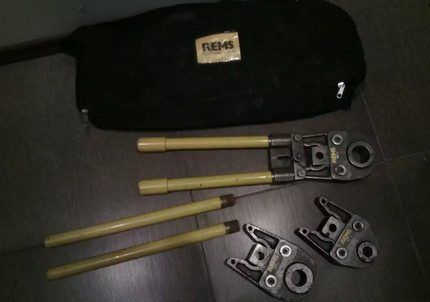
Electric and hydraulic units are somewhat more difficult to maintain and require professional maintenance. How to keep them in order can be found in the data sheet included with the equipment.
In addition to press pliers, in the assembly of a metal-plastic pipeline you will definitely need a pipe cutter, the specifics of the selection and use of which are given here. We recommend that you read this very useful information.
Conclusions and useful video on the topic
The video describes in detail how to properly use manual press pliers for crimping metal-plastic pipes.The author gives useful tips on operating the equipment and shares some secrets of high-quality processing of parts for their subsequent installation in the water supply and heating systems.
The video material is dedicated to a crimping tool operating on hydraulics. The main advantage of the presented model is the detachable design of the working head.
This allows you to use press pliers even in an inconvenient place and quickly carry out high-quality crimping of the pipe. The device has a special valve that limits the base pressure.
Press pliers operating on electric power have a lot of advantages and allow you to quickly carry out a large number of crimping operations. The head makes a full revolution around its axis and easily adapts to difficult operating conditions.
The disadvantages of the equipment include its impressive weight, the obligatory presence of an electrical outlet at hand and a rather high cost. They say that for one-time repair and installation work there is no point in buying equipment of this level. It’s better to rent it or even limit yourself to a regular manual model.
After reviewing the above information, choosing the right press pliers will be very easy even for those who rarely do repair and installation work. Additional advice will be provided to the client by sales assistants already on site in the store.
It’s not worth buying a too cheap, nameless instrument. It will not be able to provide a crimp of proper quality and will quickly fail.
It is better to pay attention to models produced by recognized global brands.They make their products from high-strength, modern materials and always provide a lifetime warranty, maintenance, and professional repair services.
Would you like to share your own experience in assembling pipelines using press jaws? Do you know technical subtleties that make sense to share with site visitors? Please write comments in the block below, ask questions, post thematic photos.




Branded pressing pliers are expensive, and if you need to crimp several diameters, then buying them is very wasteful. I rented them, it turned out to be tolerable for the money.
And what’s interesting is that I couldn’t do it right right away; I placed the fitting askew and clamped it. Consider it ruined, and compression fittings are not cheap. You need to thoroughly understand and try it on before clamping. Because a misalignment can ruin everything, then if you don’t pressurize the system, there will be leaks.